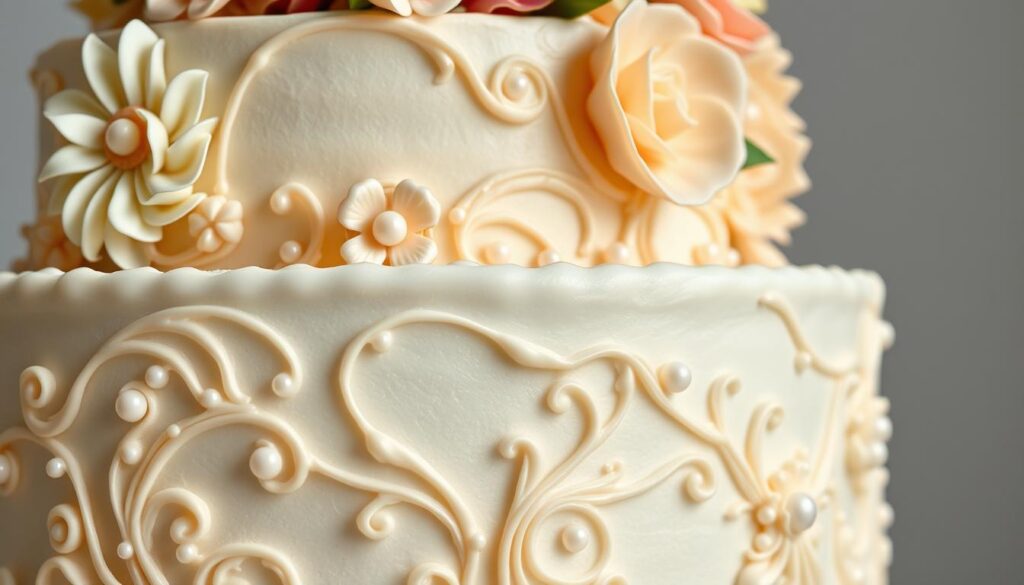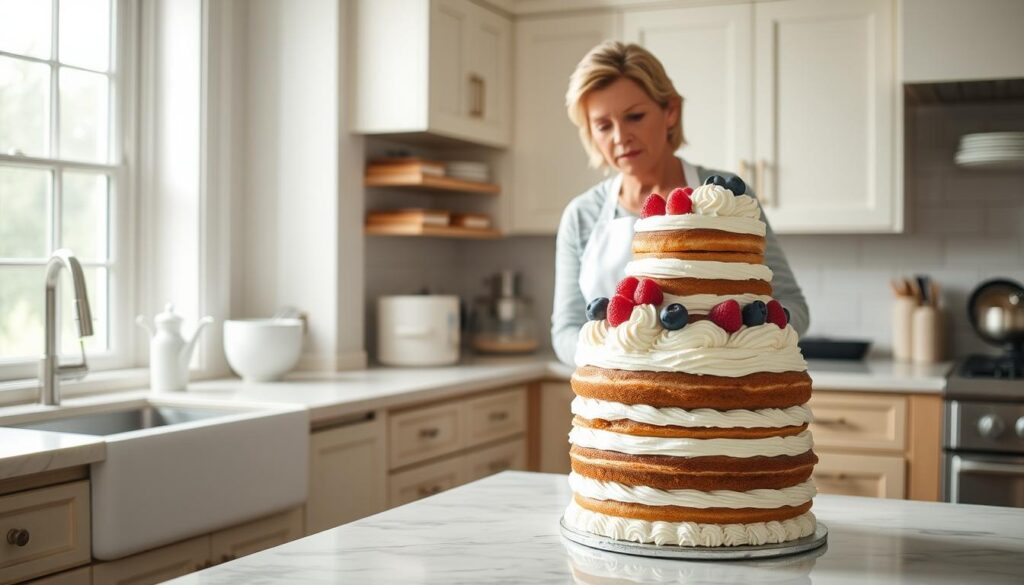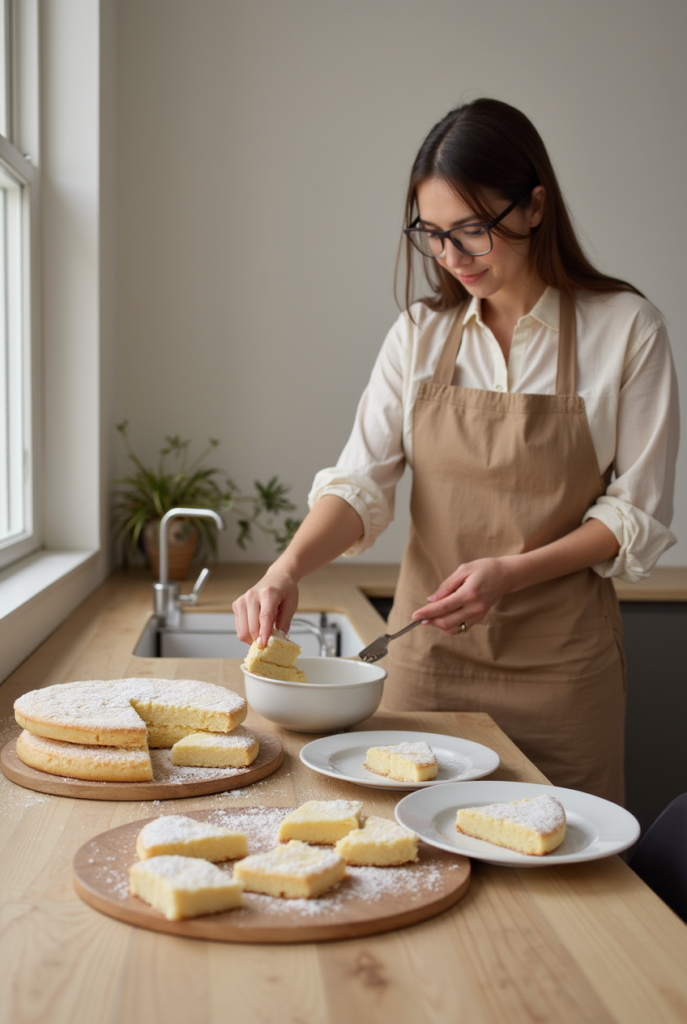Table of Contents
Every home baker dreams of making cakes that look like they’re from a pro kitchen. Martha Stewart’s recipes make this dream come true. They turn simple ingredients into amazing culinary art.
Exploring Martha Stewart’s cakes is more than just following a recipe. It’s unlocking a world of baking knowledge that has inspired millions. Her recipes are a deep dive into the science and soul of perfect baking.
Whether you’re new to baking or want to improve, this guide will help. You’ll learn the techniques that have made Martha Stewart famous. You’ll learn how to pick the best ingredients and master decorating.
Get ready for a tasty journey that will change how you bake cakes. With Martha Stewart’s help, you’ll make cakes that are both beautiful and delicious.
Getting Started with Martha Stewart’s Signature Baking Techniques
Starting with Martha Stewart’s baking is more than just a hobby. It’s about precision and the right tools. Baking is an art that needs skill, knowledge, and the right tools. Whether you’re new or experienced, learning Martha’s cake recipes begins with basic techniques.
Your baking journey starts with the right equipment and quality ingredients. Professional bakers focus on the details for success.
Essential Baking Equipment for Perfect Results
For Martha Stewart’s baking, you need quality tools for consistent results. Your must-haves include:
- Heavy-duty stand mixer
- Precise digital kitchen scale
- High-quality baking pans
- Oven thermometer
- Silicone spatulas
- Measuring cups and spoons
Understanding Martha’s Ingredient Quality Standards
Martha Stewart’s cake recipes focus on premium ingredients. Your ingredients should be:
- Fresh and high-quality
- Organic when possible
- Properly stored
- At room temperature
Basic Measurements and Conversions
Accurate measurements are key in Martha’s cake recipes. Here’s a quick guide:
| Measurement | Conversion |
|---|---|
| 1 cup | 240 ml |
| 1 tablespoon | 15 ml |
| 1 teaspoon | 5 ml |
Pro tip: Always use standardized measuring tools for consistent baking results.
Martha Stewart Cakes: A Legacy of Excellence
Martha Stewart has made a big impact on home baking. Her way of baking turns simple recipes into art. She mixes precision, creativity, and passion into every cake.
Martha Stewart’s cake philosophy is more than just recipes. She teaches the science of baking and adds beauty to each dessert. Her ideas have inspired many to bake with confidence and skill.
“Baking is about passion, precision, and personal expression.” – Martha Stewart
- Pioneered elegant home baking techniques
- Developed innovative cake decorating methods
- Created accessible recipes for home cooks
- Transformed cake baking into a sophisticated art
Her cookbooks and TV shows have made professional baking easy for everyone. Martha has shown how to make restaurant-quality cakes at home. She breaks down complex steps into simple ones.
| Baking Era | Martha Stewart’s Contribution |
|---|---|
| 1980s | Introduced gourmet home baking concepts |
| 1990s | Popularized intricate cake decorating techniques |
| 2000s | Developed comprehensive baking educational resources |
Martha Stewart has done more than share recipes. She has left a lasting legacy that inspires bakers of all levels. Her work encourages people to explore their creativity in the kitchen.
Essential Ingredients for Professional-Quality Cake Baking
Creating amazing martha stewart cake recipes begins with the right ingredients. Martha Stewart’s baking secrets focus on top-notch ingredients. These turn simple items into beautiful desserts.
Professional bakers say quality ingredients are key. The success of your cake depends on choosing the best ingredients with attention to detail.
Premium Flour Types and Their Uses
Flour types greatly affect your cake’s texture and shape. Here are the main flours for martha stewart cake recipes:
- All-Purpose Flour: Great for most cakes
- Cake Flour: Makes cakes tender and soft
- Pastry Flour: Ideal for lighter, fluffier baked goods
Choosing the Right Sweeteners
Sweeteners add flavor and affect moisture, texture, and color. Here are some options:
| Sweetener | Cake Characteristic |
|---|---|
| Granulated Sugar | Classic sweetness, even texture |
| Brown Sugar | Richer flavor, more moisture |
| Honey | Deep taste, better browning |
The Importance of Room Temperature Ingredients
For martha stewart baking perfection, know your ingredient temperatures. Eggs, butter, and milk at room temperature mix better. This makes your cake batter smoother and better textured.
- Eggs: Let sit for 30 minutes at room temperature
- Butter: Soft, but not melted
- Milk: Take out of fridge 15-20 minutes before baking
Mastering Classic Cake Mixing Methods
Getting good at making martha stewart cakes starts with knowing the basics of mixing. Professional bakers say each method is key to making cakes that taste great and feel right.
In martha stewart baking, there are a few main mixing methods that can change your baking game. Let’s look at the top techniques to boost your cake-making skills:
- Creaming Method: Great for butter-based cakes, this method beats butter and sugar until they’re light and fluffy
- Folding Technique: This is for adding delicate ingredients like whipped cream or egg whites gently
- All-in-One Method: A fast way to mix for simple, moist cakes
Knowing these mixing techniques will help you make cakes that look and taste like they’re from a pro. Each method needs special skills and care.
| Mixing Method | Best Used For | Key Technique |
|---|---|---|
| Creaming | Butter Cakes | Beat butter and sugar until pale and fluffy |
| Folding | Sponge Cakes | Gently incorporate ingredients without deflating |
| All-in-One | Quick Loaf Cakes | Mix all ingredients simultaneously |
Pro tip: Always use room temperature ingredients and avoid overmixing to keep your cakes tender and tasty.
Secrets to Perfect Cake Texture and Moisture
Creating martha stewart cakes with exceptional texture is all about understanding baking’s science. You need to master key techniques to turn simple ingredients into amazing desserts.
Martha Stewart cake recipes depend on precise chemical interactions. To get the perfect cake, pay close attention to several important factors:
- Ingredient temperature
- Mixing methodology
- Chemical interactions
- Baking environment
Understanding Cake Chemistry
Cake baking is a complex chemical reaction. Proteins in flour make gluten, while leavening agents create air pockets. The right balance makes your cake light and fluffy or dense.
Proper Mixing Techniques
Mixing is more than just combining ingredients. Gentle folding keeps air bubbles for a tender crumb. But overmixing can make your cake tough and chewy.
Temperature Control Tips
Temperature control is crucial for professional bakers. Using room temperature ingredients helps mix better and makes cakes more consistent. Preheat your oven and use an accurate thermometer for perfect baking.
“Baking is a science, and precision is key to creating exceptional cakes.” – Martha Stewart
Professional Cake Decorating Techniques

Martha Stewart’s cake decorating techniques turn simple cakes into stunning works of art. Both pros and home bakers can master these skills with the right tools and practice.
To start your cake decorating journey, you’ll need some key tools. These tools are crucial for achieving great results:
- Professional turntable for smooth rotating
- Offset spatula for precise frosting application
- Quality piping bags and tips
- Bench scraper for achieving smooth surfaces
- Decorating combs and texture tools
Learning basic decorating techniques takes time and patience. Start with simple skills like making smooth buttercream and even cake layers. Consistent pressure and steady hand movements are key when frosting.
For more advanced techniques, try intricate piping, fondant work, and adding textures. Learn to make delicate rosettes, elegant borders, and smooth gradient effects. These will wow your guests.
“Precision and creativity are the secrets to exceptional cake decorating.” – Martha Stewart’s Decorating Philosophy
Practice different piping techniques to improve your skills. Keep your pressure, angle, and speed consistent when using piping bags. Try various tip sizes to create different patterns.
Remember, cake decorating is an art. Each cake is a canvas waiting for your creative touch. Your techniques will make it come alive with beautiful, tasty designs.
Signature Martha Stewart Frosting Recipes
Mastering frosting is key for stunning desserts in martha stewart cake decorating. The right frosting technique and recipe make all the difference.
Frosting turns a simple cake into a work of art. Martha Stewart’s recipes offer several signature frosting styles. They take home baking to new heights.
Classic Buttercream Variations
Buttercream is the base for most cake decorations. Martha Stewart suggests these classic types:
- American Buttercream: Simple and sweet
- Swiss Meringue Buttercream: Silky and less sugary
- French Buttercream: Rich and luxurious
Working with Fondant
Fondant gives a smooth, professional look for special cakes. For perfect results:
- Knead fondant until it’s soft
- Roll it out evenly on powdered sugar
- Drape it over the cake
- Smooth out air bubbles
Ganache Application Methods
Ganache adds a glossy finish for chocolate fans. Pro tip: Warm ganache for a shiny drip effect. Cool ganache for a smooth coat.
These martha stewart cake decorating techniques are great for both beginners and pros. They help make desserts that look and taste amazing.
Troubleshooting Common Cake Baking Issues

Every baker faces challenges when making martha stewart cake recipes. Knowing common baking problems can make your baking experience better.
Cake disasters can happen to anyone. But, knowing how to solve these problems makes you a more confident baker. Let’s look at some common cake baking challenges and how to fix them.
Preventing Common Cake Baking Problems
- Sunken Cake Centers: Often caused by opening the oven door too early or undermixing ingredients
- Dry Cake Texture: Usually results from overbaking or using too much flour
- Uneven Baking: Can occur due to incorrect oven temperature or improper pan placement
- Cracked Cake Tops: Typically happens when oven temperature is too high
Practical Solutions for Cake Baking Challenges
| Problem | Potential Cause | Solution |
|---|---|---|
| Sunken Center | Undermixed batter | Ensure thorough mixing and proper ingredient incorporation |
| Dry Texture | Overmeasured flour | Use precise measuring techniques and level flour |
| Uneven Baking | Inconsistent oven temperature | Use an oven thermometer and rotate pans midway |
“Baking is about precision, patience, and practice.” – Martha Stewart
With these tips, you’ll be ready to tackle most martha stewart cake recipes challenges. Remember, even pros have setbacks. The important thing is to learn from each baking experience.
Creating Special Occasion Cakes the Martha Way
Learning to decorate cakes is all about making unforgettable desserts for big moments. Martha Stewart’s designs turn simple celebrations into unforgettable events. Her techniques add elegance and creativity to every bite.
For Martha Stewart’s cake designs, knowing how to match the event is key. Your cake should taste great and look amazing, too. It should also hold special meaning.
Wedding Cake Design Principles
Martha Stewart’s wedding cake tips focus on style and personal touch. Here are some important points:
- Choose a design that shows the couple’s personality
- Match colors that go well together
- Find a balance between big and small details
- Add special touches that mean something
Holiday Cake Decorating Ideas
Seasonal cakes need special designs. Martha Stewart’s tips are perfect for holidays:
- Christmas: Add metallic touches and fancy piping
- Halloween: Go for spooky yet elegant designs
- Spring: Use light, sweet sugar flowers
- Autumn: Choose warm, rich colors
Seasonal Flavor Combinations
Choosing the right flavors makes your cake stand out. Choosing the right ingredients turns a simple cake into a memorable treat.
| Season | Flavor Combination | Decoration Style |
|---|---|---|
| Summer | Lemon Lavender | Pastel Watercolor Frosting |
| Winter | Peppermint Chocolate | Crystallized Sugar Accents |
| Autumn | Spiced Pumpkin | Rustic Naked Cake Design |
By following Martha Stewart’s tips, your cakes will go from good to great. You’ll make desserts that are truly beautiful.
Conclusion
Your journey through Martha Stewart’s cake baking world has changed your kitchen. You’ve learned to make stunning cakes like those in fancy bakeries. These skills are more than just recipes; they’re a form of culinary art.
Martha Stewart’s dessert ideas open doors to creativity in the kitchen. You’ve learned how to pick the right ingredients and decorate like a pro. Her methods make baking easy and fun, even for beginners.
Keep exploring Martha Stewart’s amazing recipes. Baking is both a science and an art. With practice, patience, and passion, you’ll get better and better.
Now, you can bake like a pro. Use these techniques, try new flavors, and show off your creativity. Every cake you make will be a hit with your loved ones.
